How to manage passwords using the Bitwarden utility
Have you ever managed multiple login accounts and accidentally forgot your account login information or not? The Bitwarden utility on the browser will help users manage all logins and passwords. In particular, the data stored on Bitwarden will be encoded as end-to-end AES-256 ball, salted hashing and PBKDF2 SHA-256.
Reviewing saved passwords can use the password saving feature in your browser. However, Bitwarden is more secure, can open information stored in many devices, due to the ability to synchronize on multiple platforms that the utility provides. Currently, Bitwarden provides a full range of web browsers and smartphone devices, to facilitate the management of personal account information.
The following article will show you how to use the Bitwarden utility to manage personal login information on the web browser.
Step 1:
First of all, we will visit the Bitwarden home page to download the utility and install it in the browser.
- https://bitwarden.com/
Bitwarden supports most popular browsers today. Click on the browser you want to download in the list at Desktop.

Step 2:
For example, here I will install Bitwarden on Google Chrome browser. We proceed with the installation as other common utilities.

Step 3:
After successful installation, click on the utility icon and select Create account to create an account on Bitwarden.
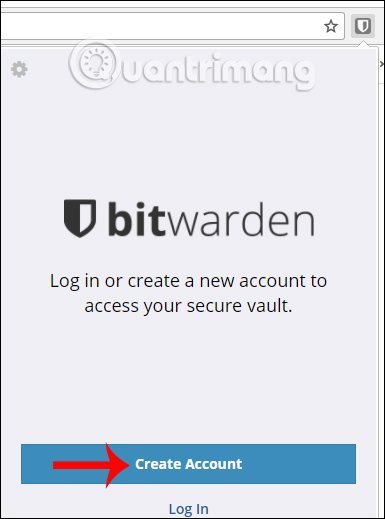
In the account creation interface, we enter the email address, the master password (Master Password) at least 8 characters, suggesting the master password (Master Password Hint) can be entered or not. Then click Submit above to submit your account information.
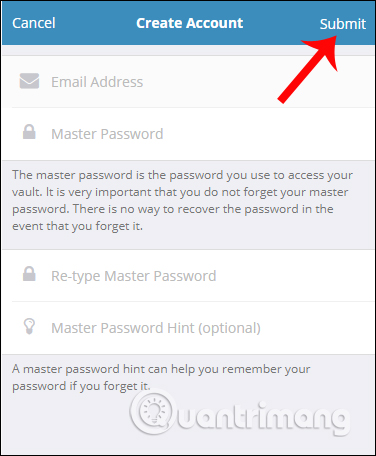
So you have successfully registered Bitwarden information. Enter your Bitwarden account and click Log in to login.
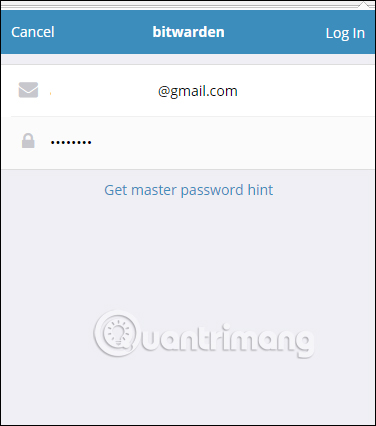
Step 4:
We will proceed to enter data as the password of the accounts. You will have 2 ways to enter the password: enter it manually and enter it automatically.
1. Enter the password manually on Bitwarden:
Step 1:
With the automatic input, we press Tab in the password entry interface, then click on the plus sign icon or click Add a Login to enter the account information.
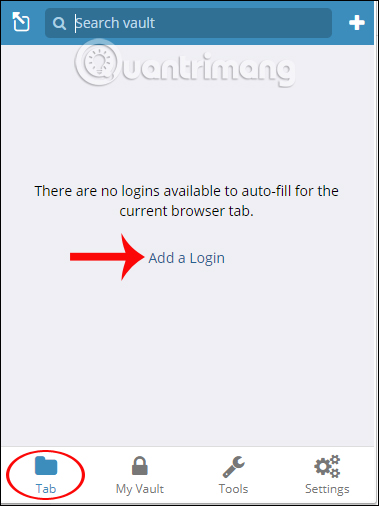
Step 2:
We will proceed to enter the website name in the Name field, address at URL, Username account name, Password at Password, authentication code at the Authenticator Key if available.
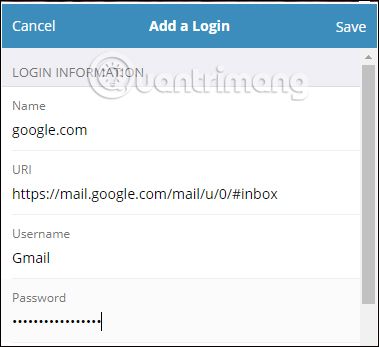
Step 3:
Next, scroll down to select the folder to save the information, select the favorite account at Favorite, add a note to the account. Finally click Save above to save.

2. Enter the automatic password on Bitwarden:
When you log in to any website, the utility will appear a pop-up bar at the top asking if you want to save this page, click Yes, Save Now to save the information.

Also with new accounts you can use the password generator that Bitwarden provides. Click Generate Password and select the characters for the password and password length, by adjusting the Horizontal bar in the Options section. Finally click Copy Password to copy and use this password.
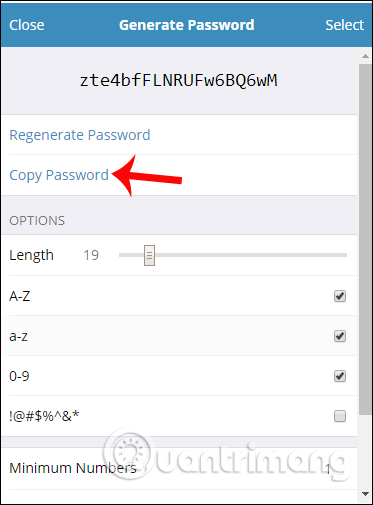
Step 5:
If you want to edit the information entered , click on the utility icon and then select the account you want to change, click the pen icon to edit.
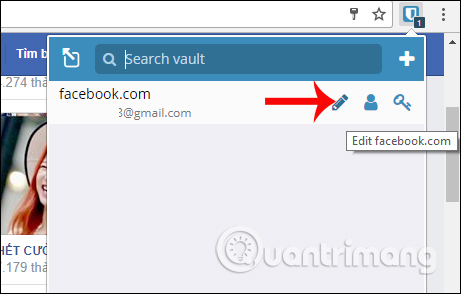
Step 6:
To enter the correct password for your saved accounts on Bitwarden, go to the website and click on the utility icon , select the Tab button then click on the account you want to log in the saved list. Login information will automatically fill in the account login section of the website.
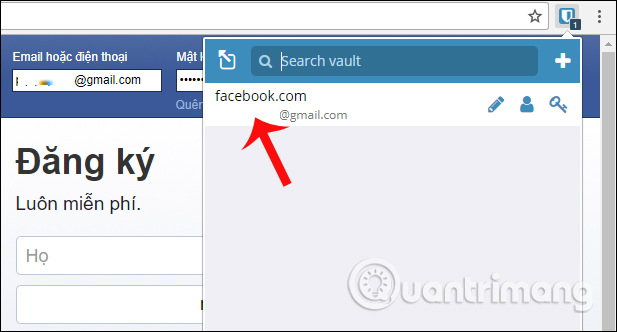
Another way to fill in that information is to right-click on the website you want to visit, select bitwarden> Autofill> select an account name . If any of the pages that sign in on a page like Google, we click twice for the corresponding account name and password.
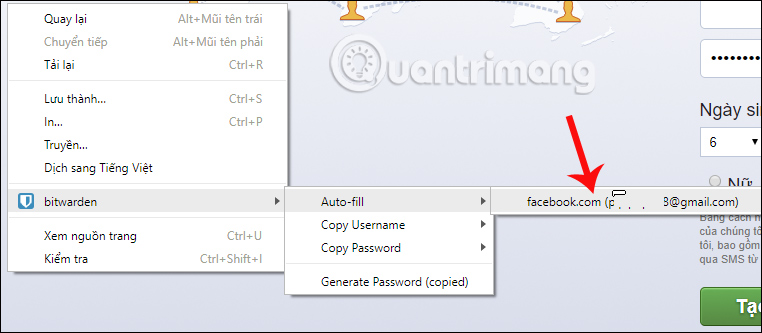
The above is how to use the Bitwarden utility to manage account login information in the browser. We won't need to use too many passwords and we can access accounts quickly on any device, via the created Bitwarden account. Besides, encryption of login information also secures personal information for users.
I wish you all success!
You should read it
- How to view the password, delete the saved password on Chrome
- 3 ways to display passwords *** on the browser is extremely simple
- Instructions for viewing saved passwords on Bchrome
- How to view saved passwords in web browsers
- How to view saved passwords on Chrome browser?
- How to view saved passwords on Chrome
- Display saved passwords on web browsers
- Instructions on how to export saved passwords on Chrome browser into 1 file
May be interested
- How to create secure passwords on Fastword
 fastword helps you to create password ranges with many different random characters, helping users to have a safe and difficult-to-guess password sequence.
fastword helps you to create password ranges with many different random characters, helping users to have a safe and difficult-to-guess password sequence. - How to manage passwords on Chrome, Coc Coc, Edge, Firefox browsers
 currently, web browsers have integrated the feature of remembering accounts and passwords of user accounts in community forums. it helps users now no need to remember the account as well as the password. however, that's why we sometimes forget the password we set
currently, web browsers have integrated the feature of remembering accounts and passwords of user accounts in community forums. it helps users now no need to remember the account as well as the password. however, that's why we sometimes forget the password we set - How to view the password, delete the saved password on Chrome
 to see the password saved on chrome you need to access chrome's password manager, by typing chrome: // settings / passwords into the address bar on chrome or by following these steps:
to see the password saved on chrome you need to access chrome's password manager, by typing chrome: // settings / passwords into the address bar on chrome or by following these steps: - How to Create Disk Images with Disk Utility (Mac OS)
 if you are running mac os x on your computer, and you want to manage your hard drive, external hard drive, or flash drive, you can os x's native software, disk utility. however, disk utility can not only manage your hard drives and other...
if you are running mac os x on your computer, and you want to manage your hard drive, external hard drive, or flash drive, you can os x's native software, disk utility. however, disk utility can not only manage your hard drives and other... - The best password management software today
 password is an indispensable part of the online world. it is almost everywhere in the internet
password is an indispensable part of the online world. it is almost everywhere in the internet - Use Password Safe in Windows 7
 password safe allows you to manage old passwords as well as easily create, save, organize, retrieve and use complex new passwords, using password policies to manage.
password safe allows you to manage old passwords as well as easily create, save, organize, retrieve and use complex new passwords, using password policies to manage. - How Linux stores and manages user passwords
 are you wondering how linux effectively manages a multi-user environment? in this article, tipsmake.com will explain how linux stores and manages user passwords and login information.
are you wondering how linux effectively manages a multi-user environment? in this article, tipsmake.com will explain how linux stores and manages user passwords and login information. - Manage, view & delete saved passwords on Coc Coc browser
 coc coc is a web browser that is being used by a lot of people, you often surf the web with coc coc and log into your accounts on websites like facebook, me.zing, gmail, etc., the password management is saved on the browser is essential.
coc coc is a web browser that is being used by a lot of people, you often surf the web with coc coc and log into your accounts on websites like facebook, me.zing, gmail, etc., the password management is saved on the browser is essential. - How to manage passwords on mPass Windows 10 - Secure account information
 to manage website account information, manage passwords more securely, many people choose to use password management software. mpass – password manager is a uwp application on windows 10 that supports keeping web accounts and passwords to avoid revealing personal information.
to manage website account information, manage passwords more securely, many people choose to use password management software. mpass – password manager is a uwp application on windows 10 that supports keeping web accounts and passwords to avoid revealing personal information. - The last 9 years Firefox has not protected user passwords carefully
 a network security researcher recently discovered that during the past 9 years, firefox has stored user passwords with an outdated process.
a network security researcher recently discovered that during the past 9 years, firefox has stored user passwords with an outdated process.










 How to convert text into speech using SpeechTexter
How to convert text into speech using SpeechTexter How to use Skyload utility to download music and videos on your computer
How to use Skyload utility to download music and videos on your computer Fix IDM error without downloading download link
Fix IDM error without downloading download link How to download MP3 from Zing MP3 to your computer
How to download MP3 from Zing MP3 to your computer How to install Savior on Chrome
How to install Savior on Chrome